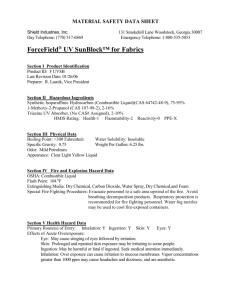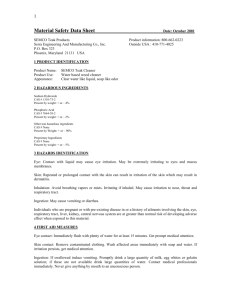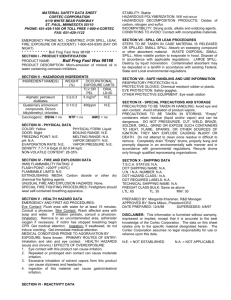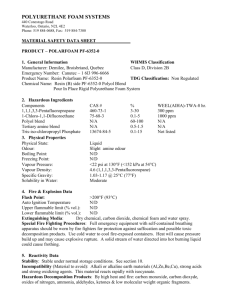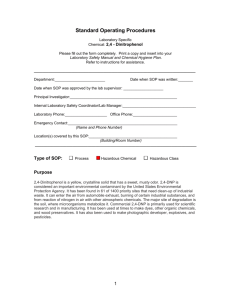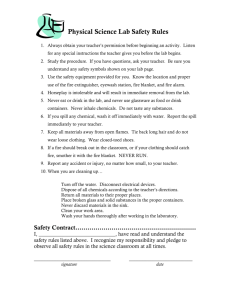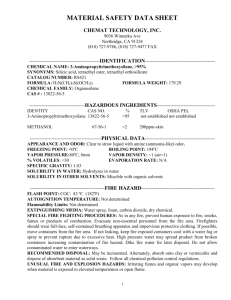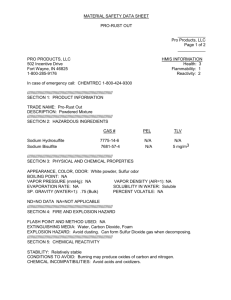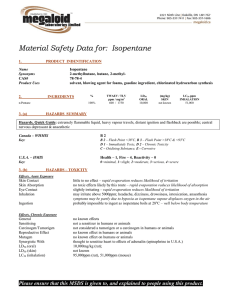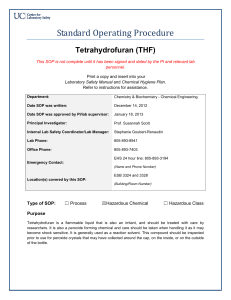Standard Operating Procedures - Environmental Health & Safety
advertisement
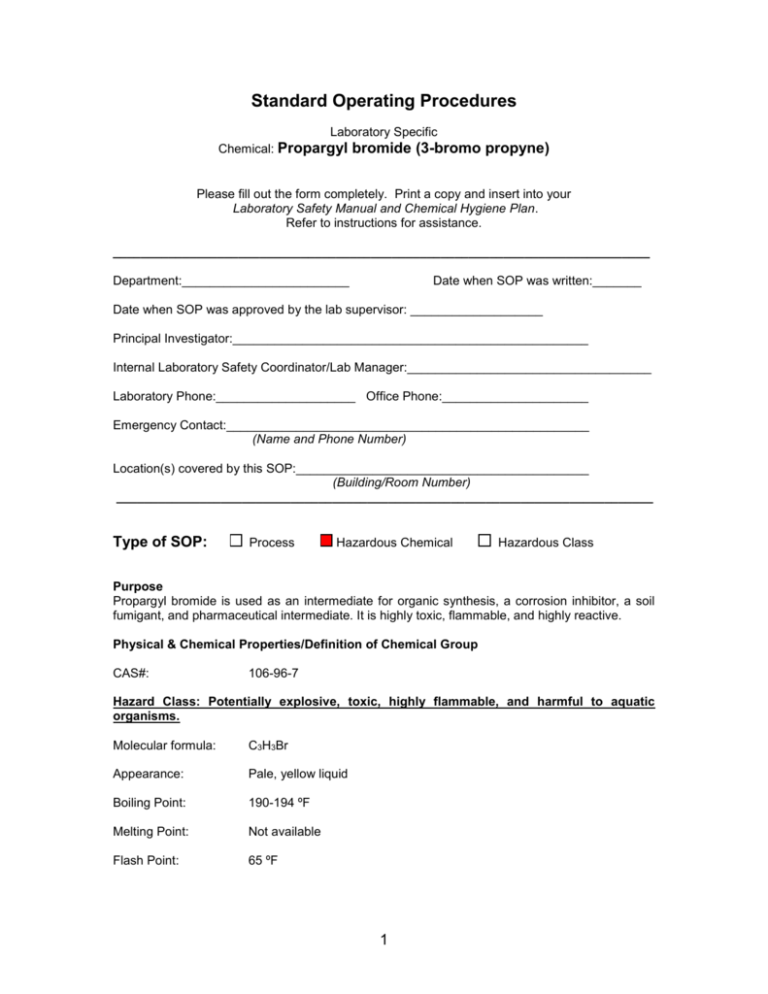
Standard Operating Procedures Laboratory Specific Chemical: Propargyl bromide (3-bromo propyne) Please fill out the form completely. Print a copy and insert into your Laboratory Safety Manual and Chemical Hygiene Plan. Refer to instructions for assistance. _____________________________________________________________________________ Department:________________________ Date when SOP was written:_______ Date when SOP was approved by the lab supervisor: ___________________ Principal Investigator:___________________________________________________ Internal Laboratory Safety Coordinator/Lab Manager:___________________________________ Laboratory Phone:____________________ Office Phone:_____________________ Emergency Contact:____________________________________________________ (Name and Phone Number) Location(s) covered by this SOP:__________________________________________ (Building/Room Number) _____________________________________________________________________________ Type of SOP: Process Hazardous Chemical Hazardous Class Purpose Propargyl bromide is used as an intermediate for organic synthesis, a corrosion inhibitor, a soil fumigant, and pharmaceutical intermediate. It is highly toxic, flammable, and highly reactive. Physical & Chemical Properties/Definition of Chemical Group CAS#: 106-96-7 Hazard Class: Potentially explosive, toxic, highly flammable, and harmful to aquatic organisms. Molecular formula: C3H3Br Appearance: Pale, yellow liquid Boiling Point: 190-194 ºF Melting Point: Not available Flash Point: 65 ºF 1 Potential Hazards/Toxicity Ingestion: Toxic effects may result from the accidental ingestion of the material; animal experiments indicate that ingestion of less than 40 gram may be fatal or may produce serious damage to the health of the individual. Eye: This material can cause eye irritation and damage in some persons. If applied to the eyes, this material causes severe eye damage and may produce a heavy secretion of tears (lachrymation). Skin: This material can cause inflammation of the skin on contact and the material may accentuate any pre-existing dermatitis condition. Skin contact with the material may damage the health of the individual; systemic effects may result following absorption. Open cuts, abraded or irritated skin should not be exposed to this material. Entry into the blood-stream, through, for example, cuts, abrasions or lesions, may produce systemic injury with harmful effects. Examine the skin prior to the use of the material and ensure that any external damage is suitably protected. Inhalation: The material can cause respiratory irritation in some persons. The body's response to such irritation can cause further lung damage. Inhalation of vapors or aerosols (mists, fumes), generated by the material during the course of normal handling, may produce serious damage to the health of the individual. Inhalation hazard is increased at higher temperatures. Chronic health effects: Long-term exposure to respiratory irritants may result in disease of the airways involving difficult breathing and related systemic problems. Substance accumulation, in the human body, may occur and may cause some concern following repeated or long-term occupational exposure. Chronic intoxication with ionic bromides, historically, has resulted from medical use of bromides but not from environmental or occupational exposure; depression, hallucinosis, and schizophreniform psychosis can be seen in the absence of other signs of intoxication. Bromides may also induce sedation, irritability, agitation, delirium, memory loss, confusion, disorientation, forgetfulness (aphasias), dysarthria, weakness, fatigue, vertigo, stupor, coma, decreased appetite, nausea and vomiting, diarrhea, hallucinations, an acne like rash on the face, legs and trunk, known as bronchoderma (seen in 25-30% of case involving bromide ion), and a profuse discharge from the nostrils (coryza). There is some evidence from animal testing that exposure to this material may result in toxic effects to the unborn baby. Personal Protective Equipment (PPE) Respirator: Personal respiratory protection should only be used as a back-up to engineering controls. In such a type A-P Filter of sufficient capacity is recommended (AS/NZS 1716 & 1715, EN 143:2000 & 149:2001, ANSI Z88 or national equivalent). Eye: Safety glasses with side shields or chemical goggles are required. Contact lenses may pose a special hazard; soft contact lenses may absorb and concentrate irritants. A written policy document, describing the wearing of lens or restrictions on use, should be created for each workplace or task. This should include a review of lens absorption and adsorption for the class of chemicals in use and an account of injury experience. Medical and first-aid personnel should be trained in their removal and suitable equipment should 2 be readily available. In the event of chemical exposure, begin eye irrigation immediately and remove contact lens as soon as possible. Lens should be removed at the first signs of eye redness or irritation - lens should be removed in a clean environment only after workers have washed hands thoroughly. [CDC NIOSH Current Intelligence Bulletin 59], [AS/NZS 1336 or national equivalent] Hands: Handle with gloves (PVC is recommended). Gloves must be inspected prior to use. Use proper glove removal technique (without touching glove's outer surface) to avoid skin contact with this product. Dispose of contaminated gloves after use in accordance with applicable laws and good laboratory practices. Wash and dry hands. Other: In addition to full length pants and closed toed shoes, a lab coat should also be worn. Flame resistant lab coats are recommended. Also consider wearing cotton underwear, socks and conductive shoes are recommended to avoid human static discharge. Engineering Controls Employees working with propargyl bromide should be authorized to do so by the employer, and work in a regulated area such as a fume hood. Within regulated areas, propargyl bromide should be stored in sealed containers. Open-vessel systems are prohibited. Each operation should be provided with continuous local exhaust ventilation so that air movement is always from ordinary work areas to the operation. Exhaust air should not be discharged to regulated areas, non-regulated areas or the external environment unless decontaminated. Clean make-up air should be introduced in sufficient volume to maintain correct operation of the local exhaust system. Except for outdoor systems, regulated areas should be maintained under negative pressure (with respect to non-regulated areas). Local exhaust ventilation requires make-up air be supplied in equal volumes to replaced air. First Aid Procedures Ingested: IF SWALLOWED, REFER FOR MEDICAL ATTENTION, WHERE POSSIBLE, WITHOUT DELAY. For advice, contact a Poisons Information Center or a doctor. Urgent hospital treatment is likely to be needed. In the meantime, qualified first-aid personnel should treat the patient following observation and employing supportive measures as indicated by the patient's condition. Eye: Immediately hold eyelids apart and flush the eye continuously with running water. Ensure complete irrigation of the eye by keeping eyelids apart and away from eye and moving the eyelids by occasionally lifting the upper and lower lids. Continue flushing until advised to stop by the Poisons Information Center or a doctor, or for at least 15 minutes. Transport to hospital or doctor without delay. Skin: Immediately remove all contaminated clothing, including footwear. Flush skin and hair with running water (and soap if available). Continue rinsing for 15 minutes. Seek medical attention in event of irritation Inhalation: If fumes or combustion products are inhaled remove from contaminated area. Lay patient down. Keep warm and rested. Prostheses such as false teeth, which may block airway, should be removed, where possible, prior to initiating first aid procedures. 3 Apply artificial respiration if not breathing, preferably with a demand valve resuscitator, bag-valve mask device, or pocket mask as trained. Perform CPR if necessary. Notes to physician: Treat symptomatically. o For poisons (where specific treatment regime is absent): Establish a patent airway with suction where necessary. Watch for signs of respiratory insufficiency, assist ventilation if needed. Administer oxygen by non-rebreather mask at 10 to 15 L/min. Monitor and treat, where necessary, for pulmonary edema. Special Handling and Storage Requirements Procedure for handling: Containers, even those that have been emptied, may contain explosive vapors. Therefore cutting, drilling, grinding, welding or performance of similar operations on or near containers should be prohibited. Avoid all personal contact, including inhalation, and DO NOT allow clothing wet with material to stay in contact with skin. Wear protective clothing when risk of exposure occurs. Use in a well-ventilated area. Prevent concentration in hollows and sumps. Recommended storage methods: Glass container is suitable for laboratory quantities. Plastic containers may only be used if approved for flammable liquid. Check that containers are clearly labeled and free from leaks. Storage requirements: Store in original containers in approved flame-proof area, away from smoking areas, naked lights, and heat or ignition sources. DO NOT store in pits, depressions, basements or areas where vapors may be trapped. Keep containers securely sealed. Spill and Accident Procedure Chemical Leak Dial 911 and x59797 Spill – Help contaminated or injured persons. Evacuate the spill area. Eliminate sources of ignition if the chemical is flammable. Provide ventilation. Prevent spreading of vapors through sewers, ventilation systems and confined areas. Evacuate unnecessary personnel. Keep others from entering contaminated area (e.g., use caution tape, barriers, etc.) Small (<1 L) – If you have training, you may assist in the clean-up effort. Use appropriate personal protective equipment and clean-up material for chemical spilled. Double bag spill waste in clear plastic bags, label and take to the next chemical waste pick-up. Large (>1 L) – Dial 911 (or 310-825-1491 from cell phone) and EH&S at x59797 for assistance. Chemical Spill on Body or Clothes – Remove clothing and rinse body thoroughly in emergency shower for at least 15 minutes. Seek medical attention. Notify supervisor and EH&S at x59797 immediately. Chemical Splash Into Eyes – Immediately rinse eyeball and inner surface of eyelid with water for 15 minutes by forcibly holding the eye open. Seek medical attention. Notify supervisor and EH&S at x59797 immediately. 4 Medical Emergency Dial 911 or x52111 Life Threatening Emergency, After Hours, Weekends And Holidays – Dial 911 (or 310-8251491 from cell phone) or contact the Ronald Reagan UCLA Medical Center (emergency room) directly at x52111 (located at 757 Westwood Plaza, enter from Gayley Avenue). Note: All serious injuries must be reported to EH&S at x59797 within 8 hours. Non-Life Threatening Emergency – Go to the Occupational Health Facility (OHF), x56771, CHS room 67-120 (This is on the 6th floor, 7th corridor, room 120. Enter through the School of Dentistry on Tiverton Drive and proceed to the “O” elevator to the 6th floor.)Hours: M - F, 7:30 a.m. to 4:30 p.m. At all other times report to Ronald Regan UCLA Medical Center (emergency room) at x52111. Note: All serious injuries must be reported to EH&S at x59797 within 8 hours. Needle stick/puncture exposure (as applicable to chemical handling procedure)– Wash the affected area with antiseptic soap and warm water for 15 minutes. For mucous membrane exposure, flush the affected area for 15 minutes using an eyewash station. Page the needle stick nurse by dialing 231 from a campus phone, enter 93333 when prompted and then enter your extension. Hours: M – F, 8:00 a.m. to 4:00 p.m. At all other times report to Ronald Regan UCLA Medical Center (emergency room) at x52111. Note: All needle stick/puncture exposures must be reported to EH&S at x59797 within 8 hours. Decontamination/Waste Disposal Procedure All waste must be handled in accordance with local, state and federal regulations. Return empty containers to supplier. Material Safety Data Sheet (MSDS) Location (State the location of MSDS) Hardcopy or electronic copy must be available. Online MSDS can be accessed at http://msds.ehs.ucla.edu. Protocol/Procedure (Add specific description of procedure.) Note: Any deviation from this SOP requires written approval from PI. Documentation of Training (signature of all users is required) I have read and understand the content of this SOP: Name Signature 5 Date
